Home | Image Library | Blog | Purchasing | Contact | About | Search
Natural History Photography Blog by Timothy Boomer
June 8, 2018 - Carson Pass Early Season Wildflowers
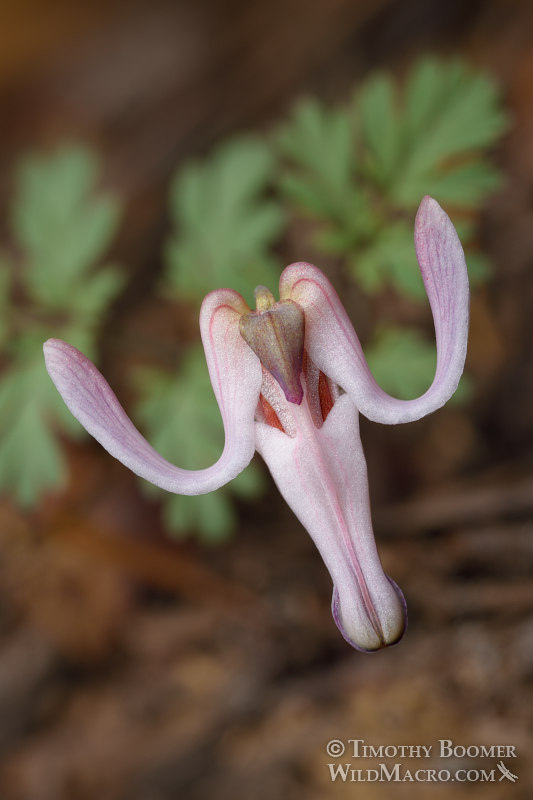
Longhorn steer's head is simply one of the coolest wildflowers I've ever seen. It may not be the most vibrantly colored plant, but how can you resist the charm of a flower that resembles a miniature bovine skull? Indeed, I couldn't resist last Sunday, when I made the long drive up to Carson Pass. I noticed a great spot for this species last year, but I had arrived a bit too late in the season, and they were already withering away. This time, I visited on the first weekend in June and was pleased to find several specimens in great condition. A few were past prime, but others were still just coming into bloom, so this upcoming weekend should be good too.
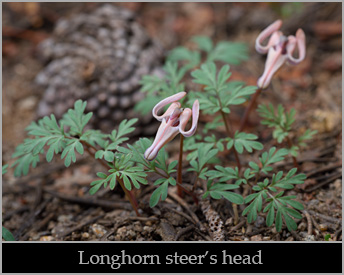 These little botanical gems are scattered throughout the Sierra, but this particular collection can be found at 38.699595, -120.001087. Park at the Meiss Trailhead on the north side of highway 88 and begin hiking west along the Pacific Crest Trail. After about 3/4 of a mile, you'll reach a small lodgepole pine forest. The steer's head will be on both sides of the trail. This is a good place for western spring beauty as well. I hope it goes without saying for my readers, but if you choose to explore this area, please tread carefully; the plants are small, delicate, and somewhat inconspicuous.
These little botanical gems are scattered throughout the Sierra, but this particular collection can be found at 38.699595, -120.001087. Park at the Meiss Trailhead on the north side of highway 88 and begin hiking west along the Pacific Crest Trail. After about 3/4 of a mile, you'll reach a small lodgepole pine forest. The steer's head will be on both sides of the trail. This is a good place for western spring beauty as well. I hope it goes without saying for my readers, but if you choose to explore this area, please tread carefully; the plants are small, delicate, and somewhat inconspicuous.
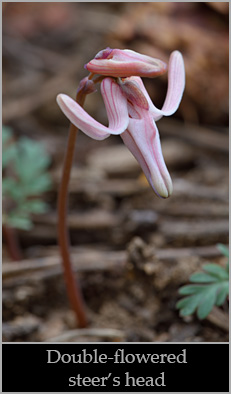 Honestly, I was happy just to see and photograph these unique plants at all, but it turns out I was in for a bigger treat. As I was examining the forest floor in search of suitable specimens, I came across what I initially mistook as the flowers of two plants tangled together. Upon closer inspection, however, it became clear that I had discovered a double-flowered steer's head! I'm not sure how rare this genetic variation actually is, but I'm impressed by any plant that dares to defy its own specific epithet. In this case, I'm referring to uniflora, which translates to "one flower."
Honestly, I was happy just to see and photograph these unique plants at all, but it turns out I was in for a bigger treat. As I was examining the forest floor in search of suitable specimens, I came across what I initially mistook as the flowers of two plants tangled together. Upon closer inspection, however, it became clear that I had discovered a double-flowered steer's head! I'm not sure how rare this genetic variation actually is, but I'm impressed by any plant that dares to defy its own specific epithet. In this case, I'm referring to uniflora, which translates to "one flower."
After I had finished up with the steer's head, I packed up my gear and continued along the trail. It's still way too early to gaze upon the vast floral displays for which Carson Pass is famous, but that doesn't mean there's nothing going on. As I made my way up the gravelly switchbacks that followed, I saw spreading phlox, wavyleaf Indian paintbrush, stickseed, Sierra wallflower, Brown's peony, and Beckwith's violet.
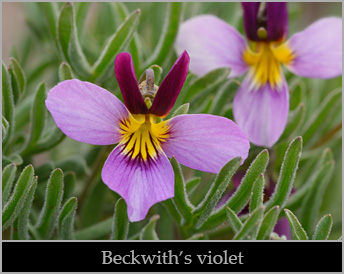 Beckwith's violet was actually the second reason I ventured up highway 88 so early in the season. I found this attractive wildflower at Martis Creek (near Truckee) three weeks prior, and I was excited by the prospect of photographing them at Carson Pass too. What I wasn't expecting is how different the same species would appear at these two places just over 40 miles apart. The flowers here were larger and more vibrant, and the leaves were hairier and more conduplicate (folded). Alas, most of these violets were already beginning to wither last weekend; I had to search awfully hard to find any in decent photographable condition.
Beckwith's violet was actually the second reason I ventured up highway 88 so early in the season. I found this attractive wildflower at Martis Creek (near Truckee) three weeks prior, and I was excited by the prospect of photographing them at Carson Pass too. What I wasn't expecting is how different the same species would appear at these two places just over 40 miles apart. The flowers here were larger and more vibrant, and the leaves were hairier and more conduplicate (folded). Alas, most of these violets were already beginning to wither last weekend; I had to search awfully hard to find any in decent photographable condition.
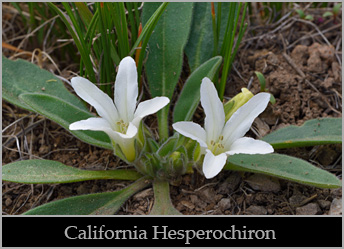 A bit further along, the trail passes by a small pond. As I approached this area, I was greeted by what sounded like a hundred frogs all singing their hearts out. They stopped when I moved closer, but started up again every time I held still long enough. I slowly crept my way around the pond, hoping to catch a glimpse of the alleged amphibians. However, they continued to elude me, so eventually I turned my attention back to the wildflowers. Bright yellow cinquefoils were all over the place, but I was more curious about a little white flower I had never noticed before. It turned out to be California Hesperochiron. That name doesn't exactly roll off the tongue, and I'll admit it's not the showiest thing around, but it's always nice to add a new species to my photographic collection. Well, that's about it for this trip, but I'm sure I'll be back at Carson Pass again before long. Thanks for looking!
A bit further along, the trail passes by a small pond. As I approached this area, I was greeted by what sounded like a hundred frogs all singing their hearts out. They stopped when I moved closer, but started up again every time I held still long enough. I slowly crept my way around the pond, hoping to catch a glimpse of the alleged amphibians. However, they continued to elude me, so eventually I turned my attention back to the wildflowers. Bright yellow cinquefoils were all over the place, but I was more curious about a little white flower I had never noticed before. It turned out to be California Hesperochiron. That name doesn't exactly roll off the tongue, and I'll admit it's not the showiest thing around, but it's always nice to add a new species to my photographic collection. Well, that's about it for this trip, but I'm sure I'll be back at Carson Pass again before long. Thanks for looking!
Blog Archive
May 15, 2018 - Sonoma Coast Wildflowers
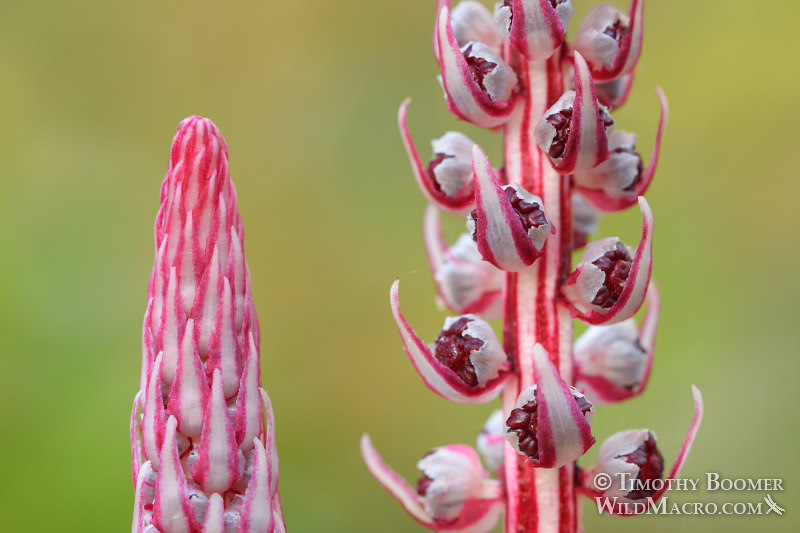
I've been fascinated by non-photosynthesizing plants ever since I first read about the phantom orchid in Michael Graf's Plants of the Tahoe Basin. Sure, these unique organisms may not have the same flamboyance as their carnivorous cousins, but there's still something quite intriguing about plants that don't require any sunlight in order to grow. As such, they tend to thrive in shady habitats where there is reduced competition from plants that obtain their energy in the "traditional" manner. As a photographer, I can especially appreciate this — not only is it nice to not have the sun beating down on the back of my neck, but the forest canopy does most of the heavy lifting in terms of softening those harsh rays.
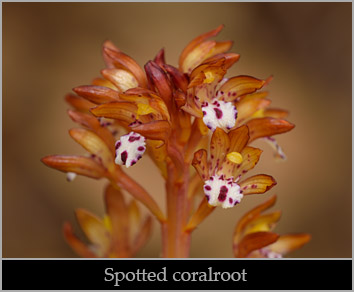 Over the years, I've had the joy of finding and photographing a number of non-photosynthesizing plants. Snow plant, whose bright red color practically screams for attention, is easy to spot even at highway speeds (not that I endorse botanizing while driving). Spotted coralroot and woodland pinedrops may not be quite as conspicuous, but are common enough to still be regularly encountered by anyone who spends enough time in the forest. Striped coralroot and the aforementioned phantom orchid tend to be harder to find, but can still be located with a bit of research and exploration. However, sugarstick and Pacific coralroot are two non-photosynthesizing species that have eluded me for quite some time. They don't seem to have a reputation of being especially rare or endangered — I had apparently just never been at the right place at the right time...that is, until May 5th, when I headed out to the Sonoma coast in hopes of finding them both.
Over the years, I've had the joy of finding and photographing a number of non-photosynthesizing plants. Snow plant, whose bright red color practically screams for attention, is easy to spot even at highway speeds (not that I endorse botanizing while driving). Spotted coralroot and woodland pinedrops may not be quite as conspicuous, but are common enough to still be regularly encountered by anyone who spends enough time in the forest. Striped coralroot and the aforementioned phantom orchid tend to be harder to find, but can still be located with a bit of research and exploration. However, sugarstick and Pacific coralroot are two non-photosynthesizing species that have eluded me for quite some time. They don't seem to have a reputation of being especially rare or endangered — I had apparently just never been at the right place at the right time...that is, until May 5th, when I headed out to the Sonoma coast in hopes of finding them both.
My search began at Kruse Rhododendron State Natural Reserve. This is a place I originally visited several years ago in search of mushrooms, but have since come to appreciate for its wonderful array of wildflowers. From CA-1, head east on Kruse Ranch Road for just under half a mile and park on either side of the road. There's only room for about a dozen cars, but I've never had trouble finding a spot before, and parking is free. Chinese Gulch Trail begins on the left side of the road, and Phillips Gulch Trail begins on the right. I took the latter, although it makes little difference since the trails form a loop.
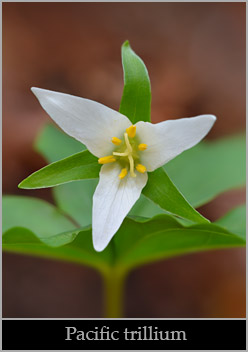 As I followed the switchbacks to make my descent, I passed by several Pacific trilliums (trillia?). Most had already gone to seed, but I was surprised to find a handful still in excellent condition. Redwood sorrel and redwood violets were all over the place, which is to be expected; it is a redwood forest after all. There were even some fairy slipper orchids scattered about. These little gems were a pleasure to see despite clearly being past their prime. I occasionally noticed some promising plants from a distance, but they kept turning out to be spotted coralroot upon closer inspection. All of these familiar plants made for a wonderfully scenic hike, but they were not the reason I drove over two and a half hours to the coast that Saturday. I kept chugging away, and it eventually paid off when I finally discovered my very first Pacific coralroot. It was about a mile into the hike, just left of the T junction and before the trail crosses the road to continue to the Chinese Gulch Trail. Note: I can't find this junction on any official map, but it is very obvious when you reach it. I'm not sure where the right direction leads.
As I followed the switchbacks to make my descent, I passed by several Pacific trilliums (trillia?). Most had already gone to seed, but I was surprised to find a handful still in excellent condition. Redwood sorrel and redwood violets were all over the place, which is to be expected; it is a redwood forest after all. There were even some fairy slipper orchids scattered about. These little gems were a pleasure to see despite clearly being past their prime. I occasionally noticed some promising plants from a distance, but they kept turning out to be spotted coralroot upon closer inspection. All of these familiar plants made for a wonderfully scenic hike, but they were not the reason I drove over two and a half hours to the coast that Saturday. I kept chugging away, and it eventually paid off when I finally discovered my very first Pacific coralroot. It was about a mile into the hike, just left of the T junction and before the trail crosses the road to continue to the Chinese Gulch Trail. Note: I can't find this junction on any official map, but it is very obvious when you reach it. I'm not sure where the right direction leads.
I actually noticed over a dozen Pacific coralroot clusters in that general vicinity. They suddenly seemed so commonplace that I began to wonder if I had been hiking past them all the while. In any case, I had plenty to choose from, so I spent a good hour finding the best specimens and photographing them. I found a few more on the Chinese Gulch Trail at some point after crossing the road, but the highest concentration definitely seemed to be between the T junction and Kruse Ranch Road.
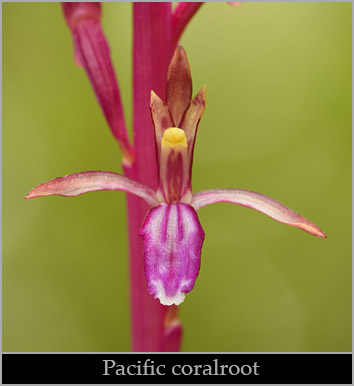
After photographing a few other subjects along the way, I eventually completed the loop back to my car around 5:30 PM. No sign of sugarstick. Checking one item off my list was indeed satisfying, but I still wanted to find the other. Fortunately, I had a good idea where to look and just enough time to get there. I headed back down highway 1 for a few miles and turned left into Salt Point's Woodside Campground parking lot. For the casual tourist looking for unusual rock formations and pretty sunsets, Gerstle Cove across the highway is definitely the way to go. However, I was a man on a mission to find a cool plant, and I knew where I was most likely to find it based on historical observations. I grabbed my equipment, checked the time with a bit of apprehension, and began hiking up Central Trail.
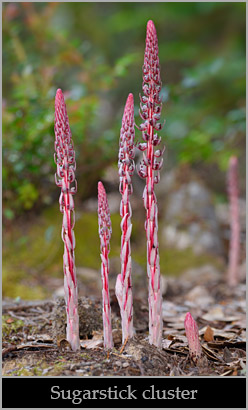 Salt Point was home to many of the same plants I had seen earlier in the day (it's basically the same forest, after all), but there were different finds as well, including some very late-blooming Indian warrior. However, with the sky growing darker by the minute, I really didn't have any time to spare. I kept pushing forward, eventually passing up the Water Tank Trail on my left. A few minutes past that point, I was honestly beginning to think my chances of finding sugarstick were pretty slim. Should I have taken that trail to the left? Had I arrived too early in the season? Maybe there just hadn't been enough rainfall this year (these non-photosynthetic plants rely on subterranean fungi for nourishment, and fungi need a lot of water). Thankfully, I didn't have to go too much further before all those worries were cast aside. On the right side of the trail, in completely plain sight, was an immaculate collection of sugarstick. Some of the stalks were still just getting started, but I didn't mind. This allowed me to show the plants at different stages all within a single shot. It also allowed me some time to write this article and still have it be relevant (that is, some of the plants should still be in good condition now, even though it has taken me ten days to finish writing about them — sorry for the delay!).
Salt Point was home to many of the same plants I had seen earlier in the day (it's basically the same forest, after all), but there were different finds as well, including some very late-blooming Indian warrior. However, with the sky growing darker by the minute, I really didn't have any time to spare. I kept pushing forward, eventually passing up the Water Tank Trail on my left. A few minutes past that point, I was honestly beginning to think my chances of finding sugarstick were pretty slim. Should I have taken that trail to the left? Had I arrived too early in the season? Maybe there just hadn't been enough rainfall this year (these non-photosynthetic plants rely on subterranean fungi for nourishment, and fungi need a lot of water). Thankfully, I didn't have to go too much further before all those worries were cast aside. On the right side of the trail, in completely plain sight, was an immaculate collection of sugarstick. Some of the stalks were still just getting started, but I didn't mind. This allowed me to show the plants at different stages all within a single shot. It also allowed me some time to write this article and still have it be relevant (that is, some of the plants should still be in good condition now, even though it has taken me ten days to finish writing about them — sorry for the delay!).
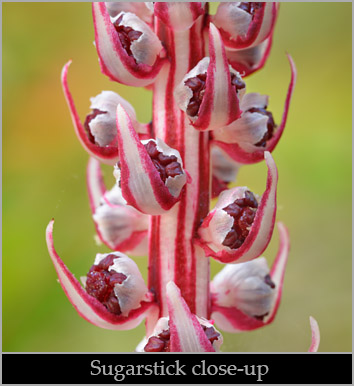
With daylight quickly dwindling away, I knew I should get right to work, but I nevertheless found myself simply marveling at the red and white botanical wonder. Not all plants are very aptly named, but sugarstick really does look like something you'd expect to find in a candy shop. I'll admit I was tempted to try a bite; anything that looks that good must be delicious, right? Fortunately, I had the good sense to start taking pictures before my appetite got the better of me. Sugarstick may not actually be candy, but it sure is a sweet find.
Blog Archive
February 24, 2018 - Fairy Slippers Now in Bloom
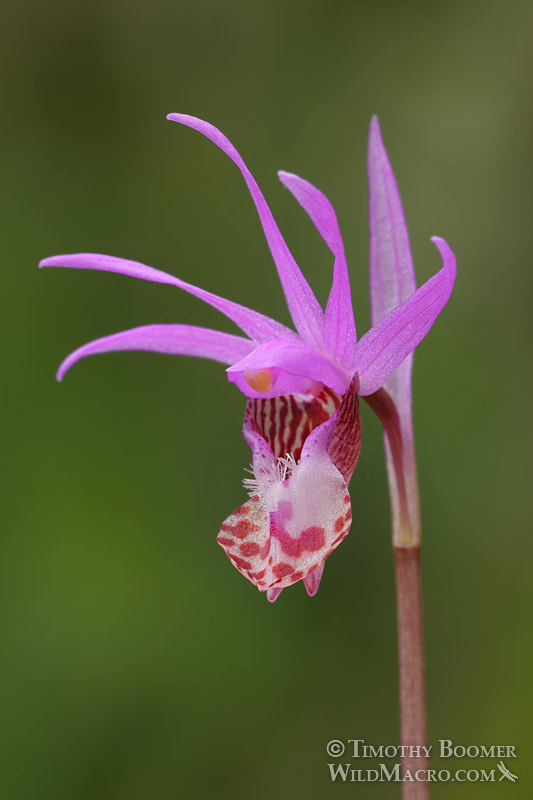
I'm pleased to report that western fairy slipper is now in bloom at Mount Tamalpais State Park. You won't find the mass quantities we had last year (no doubt due to this year's much drier winter and the fact that it's still pretty early in their season), but you shouldn't have any trouble locating some if you look in the right places. They have a close association with Douglas fir, so anywhere you see those distinctive pine cones on the ground is a good place to start searching. They seem to especially favor the shaded forest floor along the south side of Laurel Dell Road within a quarter mile of its intersection with Bernstein Trail. I'm sure there are a number of different ways to get there, but I parked at the quarry parking lot (37.914473, -122.609207) and hiked north along Lagunitas-Rock Spring Road and Bernstein Trail until I reached Laurel Dell Road. From that point, the orchids were scattered pretty obviously in either direction.
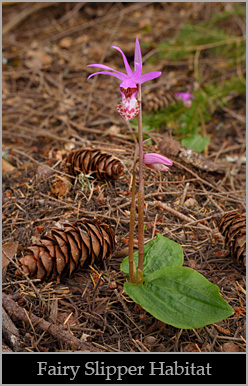 After exploring and photographing to my heart's content in that area, I decided to take a short stroll along Steep Ravine Trail from the Pan Toll Campground parking lot. I found a few fairy slippers there, but nowhere near as many as along Laurel Dell Road. However, I did find a different and completely unexpected orchid there — spotted coralroot! I didn't bother to photograph it because the wind was picking up and it was getting late, but I still marveled at it for a couple minutes. It struck me as out of place growing through the moss, and even more out of time (one of its other common names is summer coralroot after all), but I can see from iNaturalist that I'm not the only one who's seen one on Mt. Tam recently. I also noticed plenty of milkmaids, Pacific hound's tongue, and a couple Henderson's shooting stars, but the fairy slippers were definitely the highlight of day.
After exploring and photographing to my heart's content in that area, I decided to take a short stroll along Steep Ravine Trail from the Pan Toll Campground parking lot. I found a few fairy slippers there, but nowhere near as many as along Laurel Dell Road. However, I did find a different and completely unexpected orchid there — spotted coralroot! I didn't bother to photograph it because the wind was picking up and it was getting late, but I still marveled at it for a couple minutes. It struck me as out of place growing through the moss, and even more out of time (one of its other common names is summer coralroot after all), but I can see from iNaturalist that I'm not the only one who's seen one on Mt. Tam recently. I also noticed plenty of milkmaids, Pacific hound's tongue, and a couple Henderson's shooting stars, but the fairy slippers were definitely the highlight of day.
Blog Archive
September 3, 2017 - Rattlesnake Plantain Now in Bloom
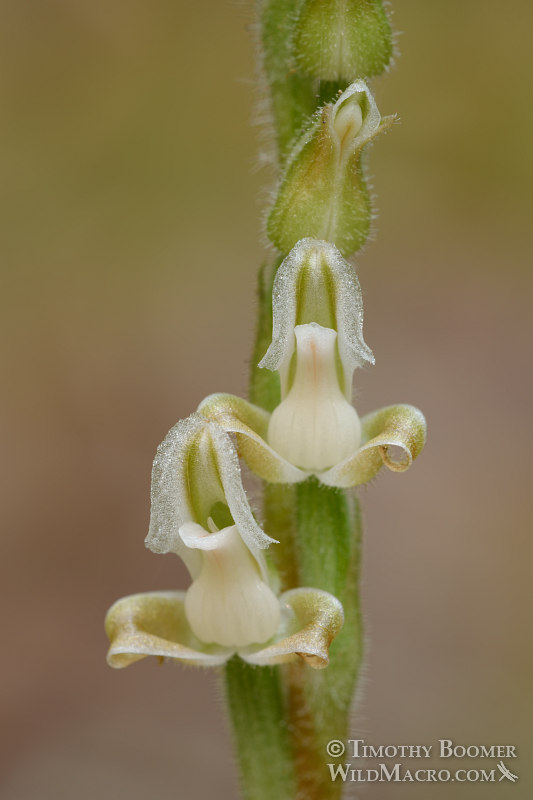
Most people who spend much time hiking through forests have probably seen the unique and attractive leaves of rattlesnake plantain (Goodyera oblongifolia). The striking foliage is present year-round, so careful timing is not required. Its flowers, however, are another story. They come into bloom late in the year when most other wildflowers have already withered away, and when most photographers have given up hope of finding any plants in decent photographable shape for the next several months.
As you might recall from my Spring Cleaning 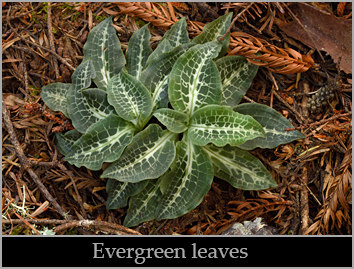 blog entry, I noticed rattlesnake plantain leaves last year at Kruse Rhododendron State Natural Reserve, just north of Salt Point State Park. I'd seen them at a number of different locations in the Sierra before, but never in great quantities and never in bloom. So when I found at least 50 different specimens along the Phillips Gulch Trail, I took note and made plans to return when I hoped the flowers would be blooming.
blog entry, I noticed rattlesnake plantain leaves last year at Kruse Rhododendron State Natural Reserve, just north of Salt Point State Park. I'd seen them at a number of different locations in the Sierra before, but never in great quantities and never in bloom. So when I found at least 50 different specimens along the Phillips Gulch Trail, I took note and made plans to return when I hoped the flowers would be blooming.
On September 2nd, I decided to give it a shot. I was initially disappointed to see that most of the plants were still just leaves, but I eventually found some specimens with tall, hairy stems and tiny, green buds near the top. This wasn't quite what I was hoping for, but it was enough to give me hope and the motivation to keep searching. I hiked at a casual pace for about an hour before finally turning back. I still hoped I would notice something different while facing the opposite direction, but I was beginning to think the odds weren't very good.
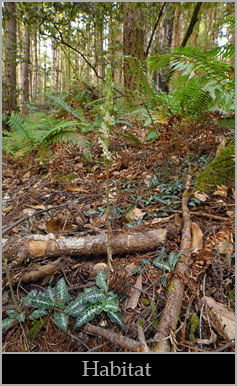 Not wanting the entire hike to be all for naught, I eventually decided to just get a picture of the leaves. I found what I thought was an attractive cluster, set up my gear, and finished within a few minutes. As I was beginning to put away my equipment, however, I noticed some more plants a little further up the hill away from the trail. Once I stood at the right spot, I could see that there were literally dozens of specimens all within 15 feet of each other. I excitedly checked them all out, and as you can tell from the picture at the beginning of this post, I'm happy to report that I finally found some rattlesnake plantain flowers in bloom!
Not wanting the entire hike to be all for naught, I eventually decided to just get a picture of the leaves. I found what I thought was an attractive cluster, set up my gear, and finished within a few minutes. As I was beginning to put away my equipment, however, I noticed some more plants a little further up the hill away from the trail. Once I stood at the right spot, I could see that there were literally dozens of specimens all within 15 feet of each other. I excitedly checked them all out, and as you can tell from the picture at the beginning of this post, I'm happy to report that I finally found some rattlesnake plantain flowers in bloom!
For those of you who'd like to see these flowers in person, you can probably go anytime in next two or three weeks, as there were a good number of plants with buds still forming. There's a small parking area on Kruse Ranch Road, about a half mile from Hwy 1. From there, start hiking down Phillips Gulch Trail on the south side of the road. You'll find rattlesnake plantain scattered occasionally beside the trail, but for the large cluster where I got these pictures, you'll have to hike for about half an hour, depending on your pace. (I was carrying a lot of heavy equipment and constantly looking for suitable photography subjects, so don't judge me if you make it there in ten minutes!) After following several switchbacks and crossing a couple small bridges, you'll have to climb over or under a fallen tree that blocks the trail. Just past that, another tree blocks the path, but it's probably easier to just walk around that one. The orchids will be on the right side of the path, just a little bit past that point (maybe 25 feet?). Please tread lightly and carefully; unlike actual rattlesnakes, these plants don't have any way to warn you if you're getting too close.
Blog Archive
Interested in buying a print or licensing a picture? Click on the purchasing link for more information or contact us with any questions you may have. Thanks for looking!
Back To Top
All images & text copyright Timothy Boomer. All rights reserved worldwide.